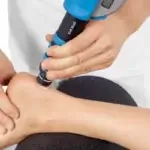Introduction
Spinal traction is a well-recognized treatment in chiropractic care, known for its efficacy in managing various spinal conditions. But did you know there are two primary types of traction – mechanical and manual? This post will delve into both details, helping you understand which might be the most beneficial for your situation.
Table of Contents
Spinal Traction: An Overview
Spinal traction is a non-surgical therapeutic technique used to relieve back pain. It involves the application of force to stretch and decompress the spine, alleviating pressure on the spinal discs and nerves. It’s often used to treat herniated discs, sciatica, degenerative disc disease, and more. The two main types of spinal traction are mechanical and manual.
Mechanical Traction: An Automated Approach
Mechanical traction is a form of spinal traction that uses an automatic device to apply force and decompress the spine. This method offers a high degree of precision with controlled and consistent details.
Understanding the Procedure
In a mechanical traction procedure, the patient lies on a specially designed table, and a harness is fastened around their hips. The automatic device is connected to the table and then applies a controlled force to the spine. The force level, direction, and duration can be adjusted based on the patient’s needs.
Benefits of Mechanical Traction
Mechanical traction offers several benefits:
- Consistency: Using a mechanical device ensures consistent and precise application of force, minimizing the risk of human error.
- Controlled Force: The force applied during mechanical traction can be easily adjusted to suit the patient’s comfort and treatment needs.
- Effectiveness: Mechanical traction has proven effective in treating several spinal conditions, providing significant pain relief and improving spinal health.
However, mechanical traction might not be suitable for all patients, particularly those with certain health conditions like severe osteoporosis, spinal fractures, or specific types of cancer.
Manual Traction: Hands-On Technique
Manual traction, as the name suggests, involves the hands-on application of force by a trained chiropractor or physical therapist. This method allows for a more personalized approach to spinal traction.
Understanding the Procedure
In a manual traction session, the healthcare provider uses their hands to pull and stretch the patient’s spine gently. They can change the direction and intensity of the force based on the patient’s feedback and their assessment of the patient’s condition.
Benefits of Manual Traction
Manual traction also has its unique benefits:
- Personalized Treatment: Manual traction allows for real-time adjustments based on the patient’s feedback, leading to a more personalized treatment experience.
- Holistic Approach: Manual traction enables the healthcare provider to use their sense of touch to assess the patient’s condition, often leading to a more holistic treatment approach.
- Flexibility: Manual traction requires no specialized equipment, making it a flexible treatment option.
Just like mechanical traction, manual traction may not suit everyone, particularly those with similar health conditions.
Mechanical Traction vs Manual Traction: Making the Choice
The choice between mechanical and manual traction depends on several factors, including the patient’s specific condition, personal preferences, and the healthcare provider’s recommendations.
Consider Your Specific Needs
Different conditions may require different types of traction. For example, mechanical traction may be more suitable if you have a severe spinal disease that requires a consistent and precise amount of force. On the other hand, if you prefer a more personalized and hands-on approach, manual traction might be a better choice.
Seeking Professional Guidance
Your healthcare provider is the best resource to guide you in choosing the most suitable form of spinal traction. They will assess your condition, consider your preferences, and recommend the most effective treatment plan.
What to Expect During Your Treatment Sessions
Knowing what to expect during your treatment sessions is helpful regardless of the type of spinal traction you choose. You’ll generally be positioned on the treatment table for mechanical and manual traction.
In a mechanical traction session, a harness will be attached around your hips, connected to a machine controlled by your therapist. The device will apply gentle, consistent force along your spine, stretching it to alleviate pressure on your spinal discs and nerves.
During a manual traction session, your therapist will use their hands to apply force to your spine. You can provide real-time feedback, helping the therapist adjust the direction and intensity of the party as needed.
Both methods aim to relieve pain and improve your spine’s health and functionality. Each session’s length may vary, but you should anticipate spending between 15 and 30 minutes on the treatment table.
The Role of Patient Preferences
While your specific medical needs are paramount in deciding between mechanical and manual spinal traction, your comfort and preferences also play a crucial role. Some patients prefer the consistent and measurable forces that mechanical traction provides. Others might favour the personalized touch that comes with manual traction. Being comfortable with and trusting your chosen method can enhance the treatment’s effectiveness.
Complementary Therapies
Often, spinal traction — whether mechanical or manual — isn’t used in isolation. It’s typically part of a broader treatment plan, including spinal adjustments, massage, heat or cold therapy, ultrasound therapy, and physical exercise. These complementary therapies can help enhance the benefits of spinal traction, speed up recovery, and prevent future spinal issues.
Ensuring Long-Term Success
It’s important to remember that while spinal traction can provide notable immediate relief, long-term improvements typically require a series of treatments along with lifestyle changes. Maintaining good posture, practising back-strengthening exercises, and leading an active lifestyle can all contribute to spinal health and complement the benefits of spinal traction.
Conclusion:
In conclusion, State Line Chiro Center is your trusted partner in navigating the world of spinal health, offering both mechanical and manual traction options. Their experienced team is committed to understanding your unique needs, preferences, and health status to guide you towards the most suitable treatment options.
Whether you benefit more from the precision of mechanical traction or the personal touch of manual traction, State Line Chiro Center is here to provide the care and expertise you need. Embark on your journey towards improved spinal health with the expert team at State Line Chiro Center, and experience the difference personalized, top-tier chiropractic care can make in your life.




